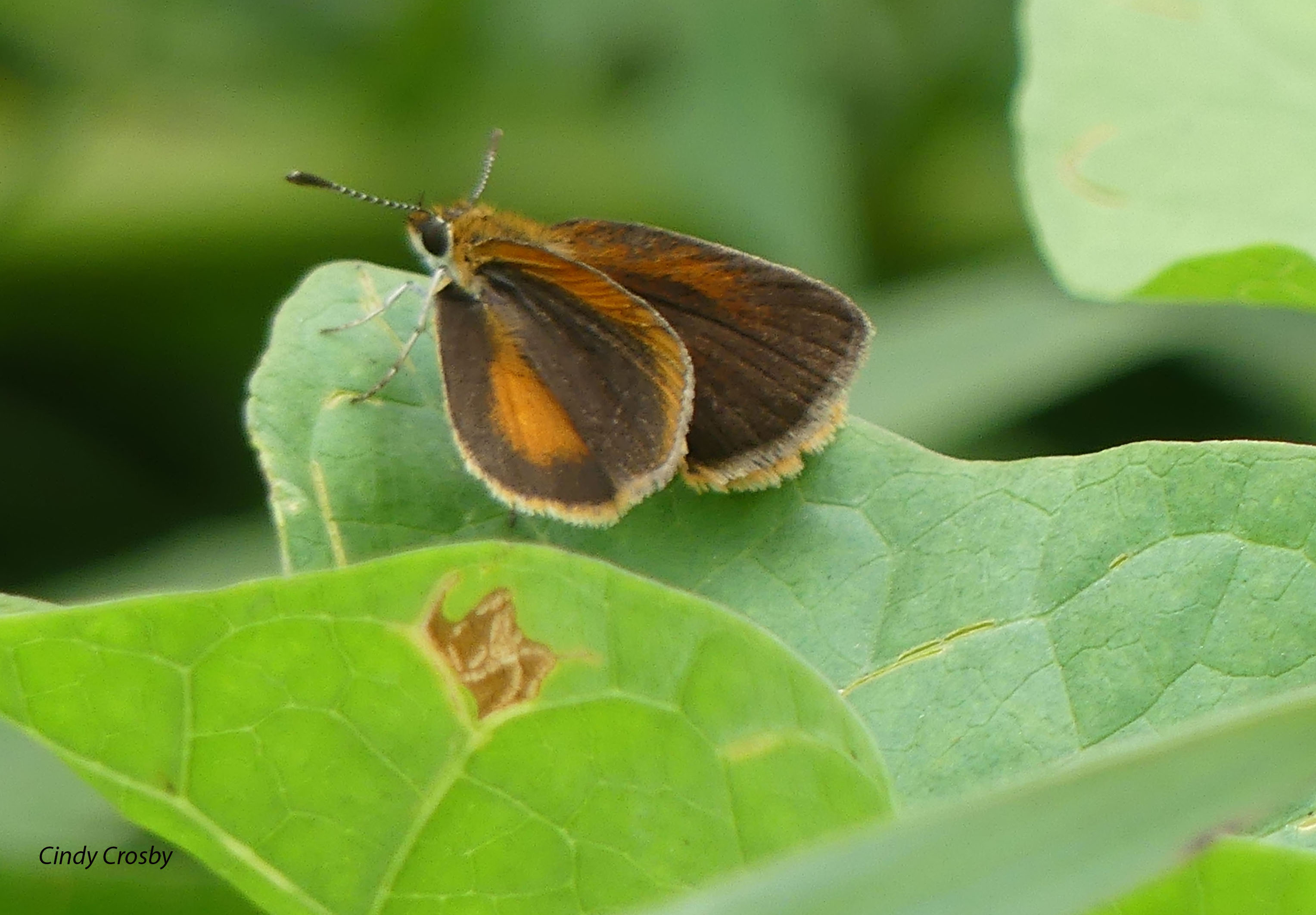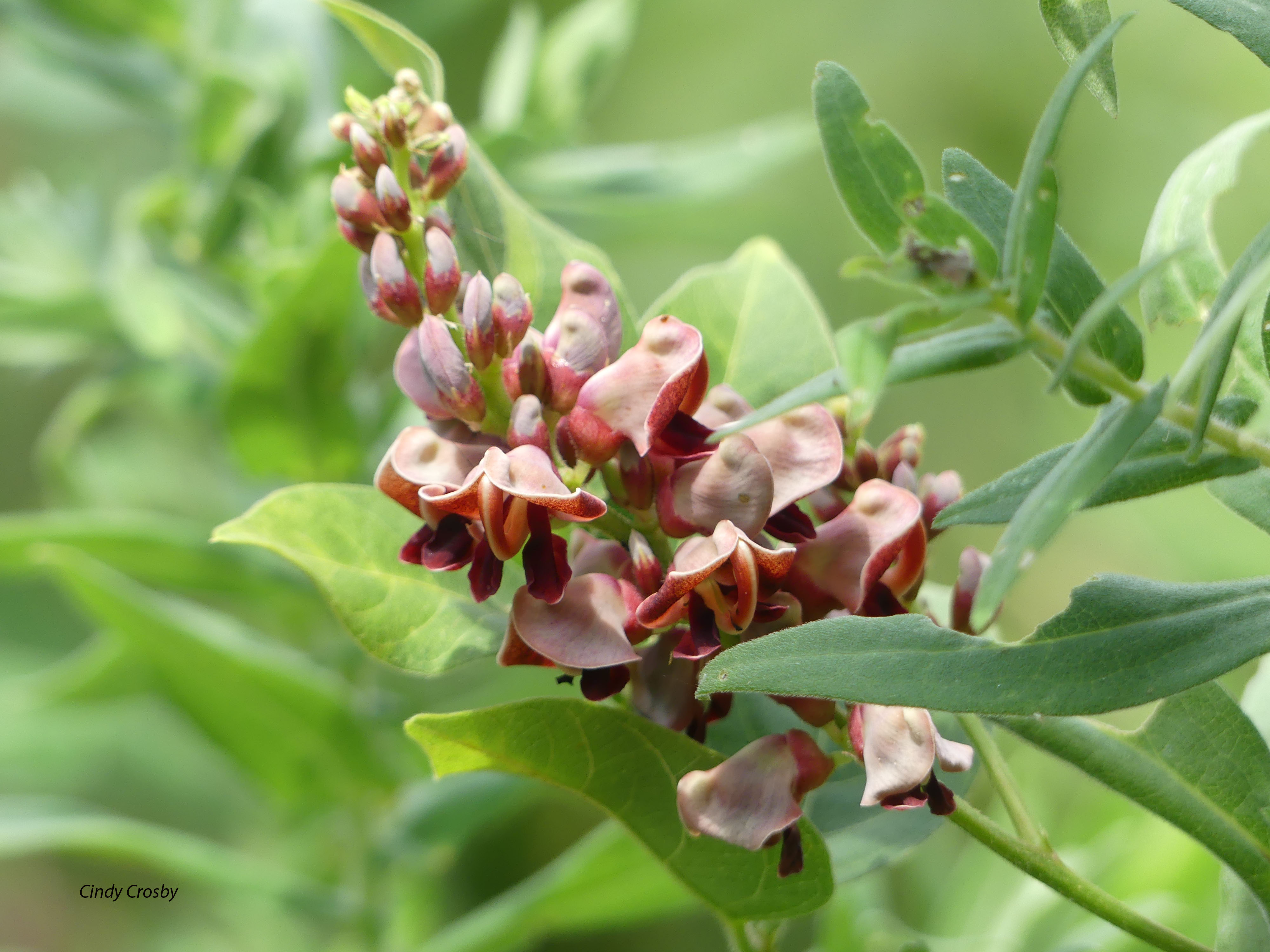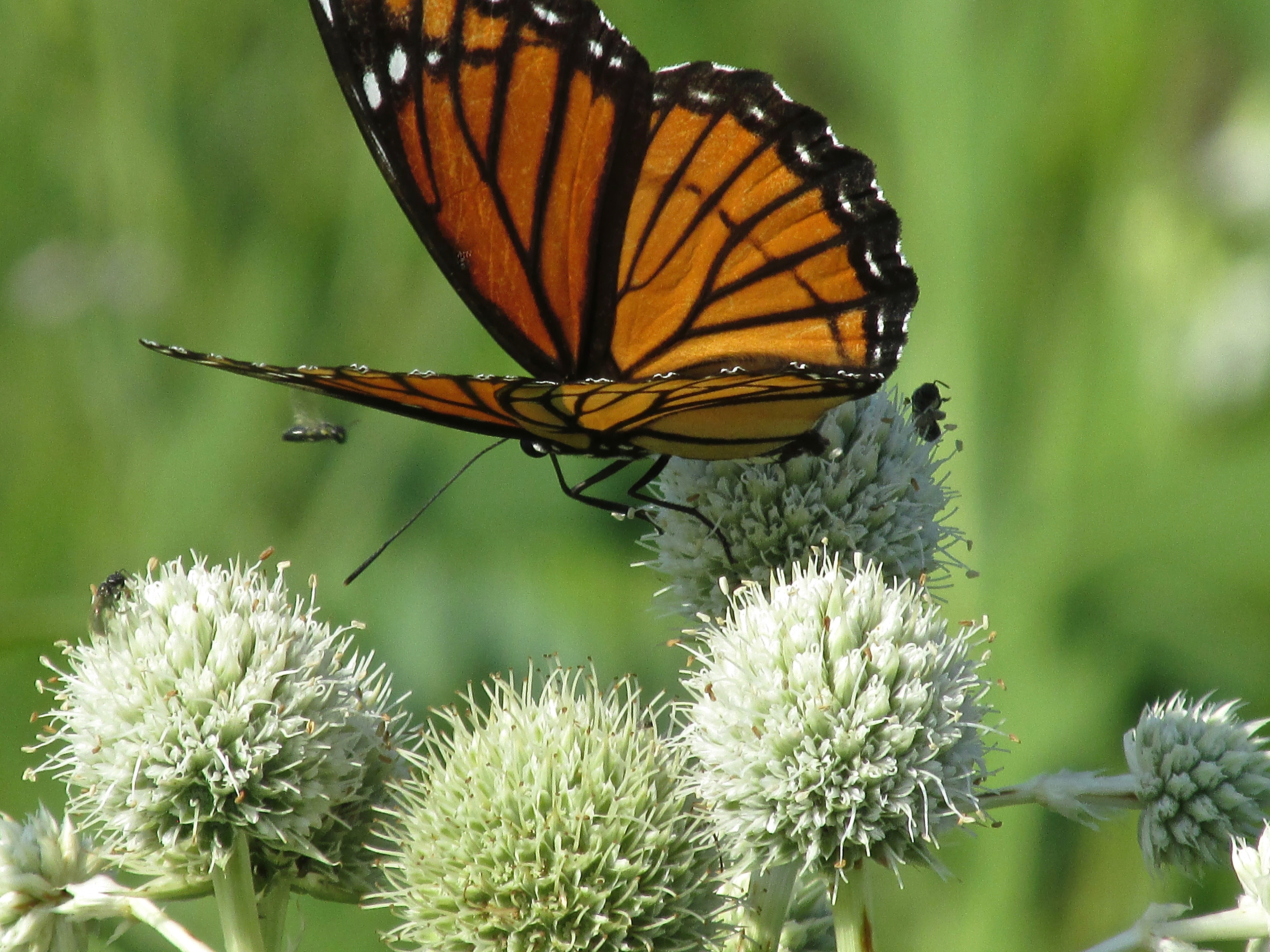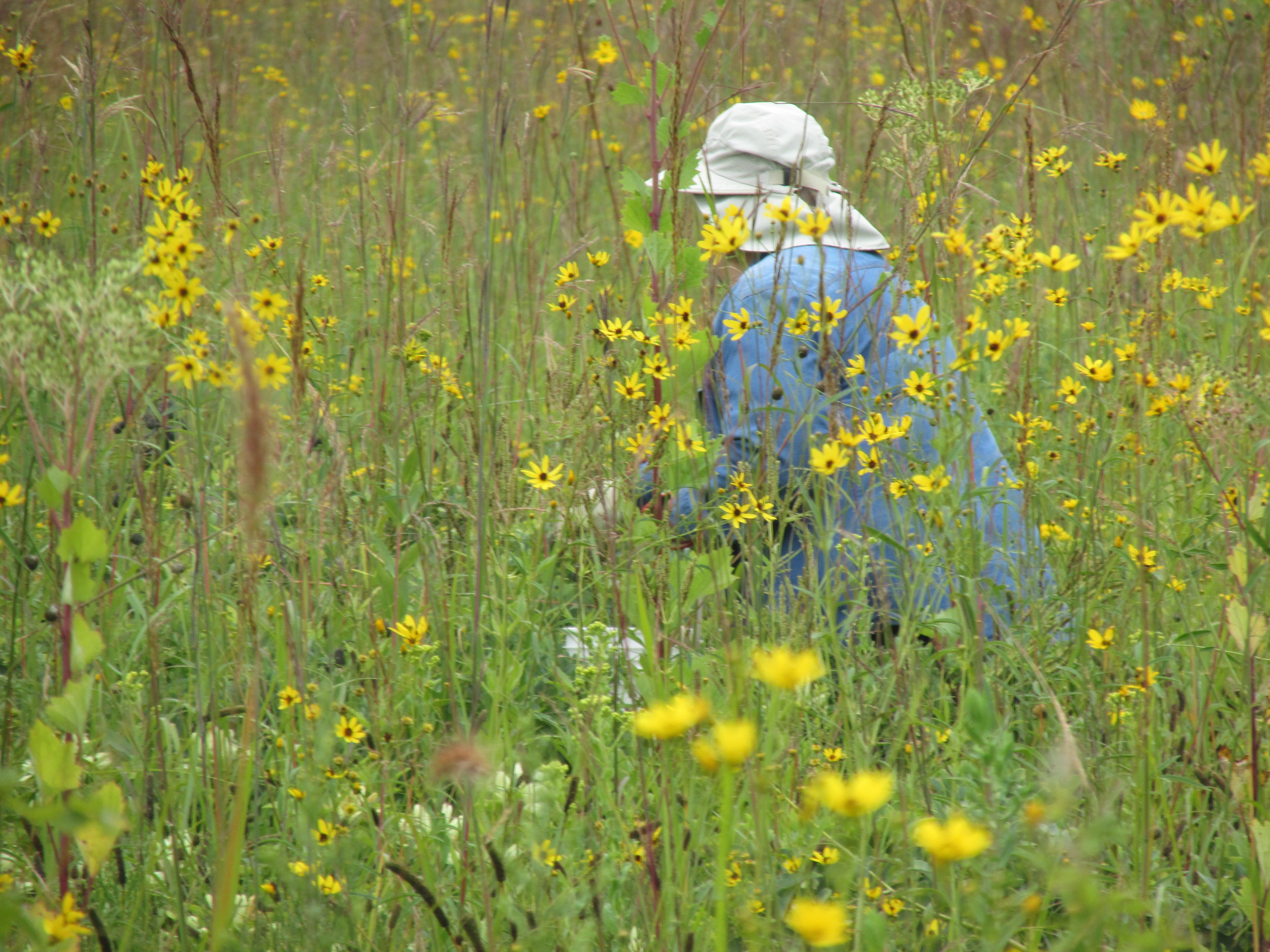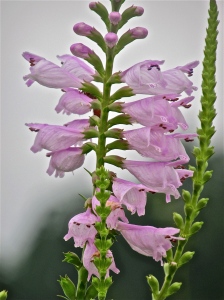“…Burning summers when the world lies green and billowy beneath a brilliant sky, when one is fairly stifled in vegetation, in the color and smell of strong weeds and heavy harvests… .”–Willa Cather
*****
Late August promises to blow the tops off the thermometers here in the Midwest.

With “real feel” over 110 degrees at times this week, a virtual hike on the prairie sounds good.

Let’s do it.
Head for the shaded prairie stream. Feel the temperature drop.

What’s that plant twining its way toward the water?

American hog peanut! What a hilarious name. Later, I read more about it, and discover it’s a host plant for the silver-spotted skipper.

Who would have thought?
Lean over the bridge, and watch the life of the stream.

But some usual damselflies are missing. I’m not seeing two regulars of this prairie stream: the American Rubyspot damselfly…

…and the Ebony Jewelwing damselfly.

Plenty of stream bluet damselflies cruise along. But where are my old favorites? Completely absent. And then–oh no! Two unlucky variable dancer damselflies are caught in a spider web slung across the brook.

Drama! They are on the breakfast menu this morning in the circle of life.

The life of a damselfly is so short. Not only is their natural lifespan only a few weeks; predators are everywhere. Swallows are ready to pick them off in an instant.

Frogs watch for an opportunity to snack on a damselfly or two. Zip. Snap! Yum.

Knowing how short many of their lives are reminds me to appreciate prairie insects when I see them. The small, and the overlooked. As well as the beautiful dragonflies and damselflies. Speaking of which.

Over the streams…

…prairies…

…lakes, rivers…

…and ponds this week, several species of dragonflies mass for migration in Illinois.

They’ll trade the sizzling heat for a more southern destination; a dubious swap. Where will they end their journey? The Gulf Coast? Central America? We know so little about dragonfly migration. Every year, when these swarms show up, it reminds me that the natural world is full of endless mystery.

And that’s just the beginnings of the mysteries that beckon to be unraveled on the tallgrass prairie, our landscape of home.

I like a good mystery or two. Pretty cool on a hot day.
****
The opening quote is by Willa Cather (1873-1947) from My Antonia. It contains many memorable passages about the tallgrass prairie, including one of my favorites: “More than anything else I felt motion in the landscape; in the fresh, easy-blowing morning wind; and in the earth itself, as if the shaggy grass were a sort of loose hide, and underneath it herds of wild buffalo were galloping, galloping… .”
*****
Upcoming Programs and Classes
September 6 — The Tallgrass Prairie: Grocery Store, Apothecary, and Love Charm Shop, hosted by Field and Flower Garden Club, Lake Barrington, IL. (Closed event for members)
September 11— Literary Gardens, hosted by the Long Grove-Killdeer Garden Club, Barrington, IL (Closed event for members)
September 21-– The Tallgrass Prairie in Art, Music, and Literature, hosted by the Lincolnshire Garden Club (Closed event for members).
September 26 — Dragonflies and Damselflies: The Garden’s Frequent Fliers, 1-2:30 p.m., hosted by the Itasca Garden Club (Itasca Park District Recreation Center). Free and open to the public!
September 27 — Literary Gardens, hosted by the Barrington Public Library (Barrington, IL). Free and open to the public! For more information and to register, call 847-382-1300.
*****
A note to my wonderful readers: Jeff and I are celebrating our 40th anniversary by visiting 40 natural areas over the summer and fall this year. Please let us know where you think we should head to next. Thanks to everyone who has sent ideas! We’re more than halfway there–thirteen more to go. So far, we’ve enjoyed visiting the following places:
Kayaking at #1 Rock Cut State Park (Rockford, IL); hiking at #2 James “Pate” Philip State Park (Bartlett, IL); #3 Potato Creek State Park (North Liberty, IN); #4 Indiana Dunes State Park (Porter County, IN); #5 Indiana Dunes National Park (Beverly Shores, IN); kayaking Silver Lake at #6 Blackwell Forest Preserve (Wheaton/Warrenville, IL); hiking #7 Belmont Prairie Nature Preserve (Downers Grove, IL), #8 Winfield Mounds Forest Preserve (Winfield, IL), #9 Bluff Spring Fen (Elgin, IL), #10 Herrick Lake Forest Preserve (Wheaton, IL); Jeff’s family reunion at #11 Hawthorn Park (Terre Haute, IN); hiking #12 Turkey Run State Park, Marshall, IN) and at #13 Shades State Park, Waveland, IN; hiking and bison viewing at #14 Kankakee Sands, Morocco, IN; hiking at #15 Hidden Lake Forest Preserve (Downers Grove, IL), #16 Peck Farm Park (Geneva, IL), #17 Schulenberg Prairie, The Morton Arboretum (Lisle, IL); #18 Busse Woods Forest Preserve, Elk Grove, IL; #19 Nachusa Grasslands (Franklin Grove, IL); reading in a swing along the Rock River at #20 Lowell Park (Dixon, IL); cabin overnight and hiking at #21 White Pines State Park (Mt. Morris, IL); hiking to the overlook at #22 Castle Rock State Park (Oregon, IL); enjoying the views at a prairie remnant gem #23 Beach Cemetery Prairie (Ogle County, IL); #24 Springbrook Prairie (Naperville, IL); watching eagles and hiking at #25 Starved Rock State Park (Oglesby, IL); watching the dragonfly migration at #26 Matthiessen State Park (Oglesby, IL); river overlook at #27 Buffalo Rock State Park (Ottawa, IL). Thanks to everyone who sent suggestions last week!
























































































